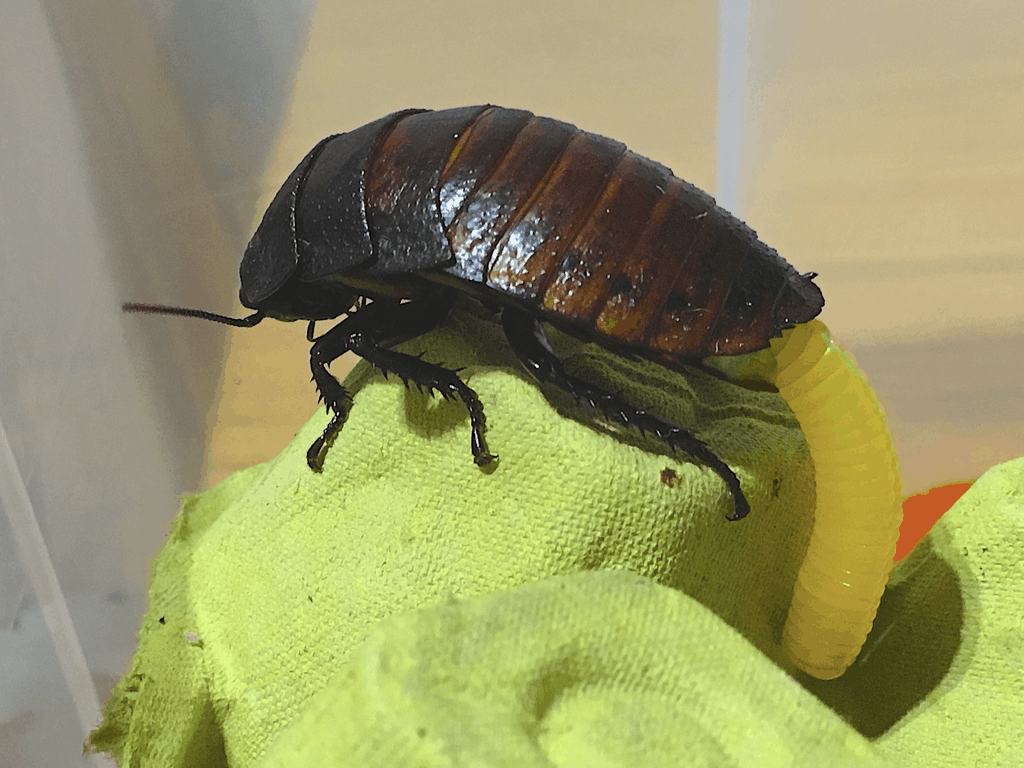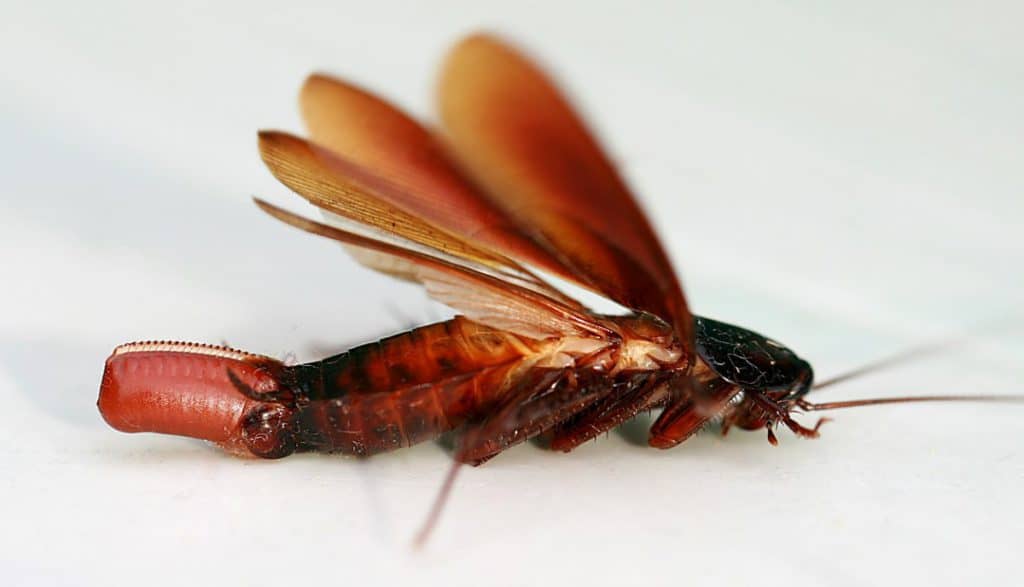
If you enjoy reading this article, why not check out our articles on 15 Unusual Facts About Cockroaches That Will Keep You Up at Night and Everything You Need to Know About Where Cockroaches Live
What Do I Do if I Find Cockroach Eggs?
Cockroach eggs are big enough to be seen without the aid of any type of technology. They are about the size of a bean. We normally cannot find them because they pasted onto well-hidden surfaces, usually in the dark and out of our reach. even experts have a hard time finding them.
Cockroaches hatch their eggs and hide them in a secure place. When the nymphs (baby cockroaches) are born, they are totally on their own to find food and water. That is why cockroaches have to find ideal places for their nymphs to survive. They tend to look for dark, humid. warm, and rarely visited areas (preferably where there are food and water).
First of all, maybe you want to know how cockroaches lay their eggs? It’s pretty interesting. Read about it in 15 Unusual Facts About Cockroaches That Will Keep You Up at Night!
Where do cockroaches carry their eggs?
The most common places where they lay their eggs are tight crevices, holes, and cracks inside kitchens, bathrooms, and basements. However, you can find them in a great variety of other locations, like: under the furniture, behind painting frames, on appliances, ceilings, pages of books, cupboards, electronics, baseboards, drawers, drainage, and sewer pipes, and near garbage deposits.
What do Cockroach Eggs Look Like?

Cockroaches lay their eggs inside egg cases called “ootheca”. These egg casings harden within hours and help protect the eggs against predators. Depending on the species, these cases can be yellowish-brown, dark brown, or reddish-brown. Their shape is somewhat between a cylinder and an ellipsoid, and sometimes with parallel transversal lines. They also have bilateral symmetry. They measure from 5 to 13 mm long. The female carries the ootheca in the rear end of her body for several days (or even weeks in some species). Then she pastes it on a secure location.
The ootheca opens up from one side, like a coin purse. If you force an egg case open, you will find the two interior sides to have a white and glossy texture, made with parallel, transversal lines. After examining this texture better, you will notice that these are the eggs.
Are cockroach eggs visible?
Yes, they are white, long ellipsoidal eggs densely packed one beside the other on both sides of the egg case. It looks so efficiently packed, that you could compare it with some mass-produced item.
When the eggs develop, all the nymphs get out of the ootheca at the same time through the longitudinal opening. They are so crowded that they can barely move as they get out. Once they are out, they spread their legs and they look like tiny, whitish semi-transparent cockroaches, with still undeveloped wings. As they grow old, they will slowly become opaque brown.
How does an Ootheca Work?
Oothecae are made out of water, proteins, and several other compounds. Besides acting like protective shields, they also evolved to keep the eggs in ideal conditions of humidity and temperature, despite the weather outside.
One of the most interesting aspects of the ootheca is how its outer covering changes as the humidity in the environment varies, to keep the eggs with the ideal condition of moist. When the climate is dry, its outer covering becomes porous to prevent the eggs from drying and when it is humid it turns smooth, to keep the eggs from receiving excessive water. If this was a design using modern technology, it would be called an “intelligent” surface (because it self-regulates).
How to Tell the Difference Between Cockroach Eggs and those from other Insects?
Oothecae of cockroaches can be distinguished by their very regular oval shape, bilateral symmetry, and glossy brown color. Considering that there are more than 4,000 different species of cockroaches in the world, and the fact that the differences of their oothecae are minimal, the egg casings of some of those species could be confused with those of other cockroaches.
There are other insects that lay eggs in oothecae, too. Most of the times these are clearly different than those of cockroaches. However, at first glance, some of them could be confused with those of a cockroach. Despite their strong similarities, there is always some characteristic missing on those egg casings that distinguishes them: maybe they have several different colors, their shape is not totally regular, they are lacking bilateral symmetry, they are not uniformly brown, etc. If there is doubt, you can consult an expert.
Do Cockroaches Lay Eggs in Clothes?

Cockroaches lay their eggs where they are hidden and protected. You can find them almost anywhere. If there is an infestation and they tend to wander inside the closets, they could lay eggs in the clothes. It doesn’t matter if the clothes are hanging or folded, this can always happen (especially if the clothes are stored for a long time). The egg casings are very visible once you get the clothes out of the closet. If the clothes happen to be brown and have a coarse texture, it may take time to see the egg casing (despite its visible size.
Are all Cockroach Eggs the Same?
Cockroach egg casings vary a little bit in their color, proportion, and size, depending on the species. Also, the transversal parallel lines are not very noticing in some species. In general, oothecae of all species of cockroach look more or less the same way. If you compare two or three oothecae of different species, you can get the idea of what they look like. Actually, the cockroach egg casings look kind of elegant, with their glossy texture and their organized, parallel transversal lines (nothing like their disgusting parents).
How Many Eggs Can a Cockroach Lay?
A female cockroach lives for about two years. She mates only once throughout her life but keeps enough sperm to produce about 7 oothecas in her existence. Each ootheca can contain from 16 to 50 eggs, depending on the species. The amount of time that these eggs take to hatch is determined by the type of cockroach (from 25 days to two months). Nymphs become adults and are ready to mate after two months have passed from their birth. This means that every female cockroach can have hundreds of cockroaches in less than two years. When they live inside a house, they can increase their population exponentially and become a problem in very little time.
How to get rid of cockroaches
Maybe you need help deciding whether or not one or two cockroaches in your house is a big problem… read our article I Saw One Cockroach, Should I Be Worried? to find out!
Biological Pest Control
One of the natural ways in which nature diminishes pest population is by the existence of predators. There are a lot of animals that eat adult cockroaches (mammals, reptiles, amphibians, etc.). Some people are interested in biological pest control, which is a method of controlling pests by including other animals or plants in the ecosystem. Some people believe that parasitic insects (insects that inject parasites on other animals) could be used someday in houses as pest control for cockroaches. I don’t know who would enjoy having wasps in their houses, but it is an alternative solution to the problems that cockroaches cause in some homes.
The Ampulicidae is a family of cockroach wasps that inject their larvae inside cockroaches (and eat them). There are two types of wasps from this family that keep the population of some species of cockroaches from growing in Hawaii: Ampulex compressa and Dolichurus stantoni.
There are other wasp families which attack the cockroach oothecae directly. An example is the Evaniidae, whose larvae grow inside the cockroach oothecae and feed on cockroaches, too. The Evania apendigaster belongs to this family, and it reproduces ni introducing its eggs inside cockroach oothecae. The wasp larvae feed on the cockroach eggs and when they develop, they leave the ootheca. This species attacks several different species of cockroaches.
There are several other species of parasitic wasps that can keep control of the cockroach population. For example, the Comperia merceti, which is a parasitoid that has control over the population of the brown banded cockroach by injecting parasites in their eggs. Another parasitic wasp is the Aprostocetus hagenowii eats the eggs of the american cockroach and injects parasites in them, too.
Conclusion
Cockroaches have roamed the earth for millions of years (before the dinosaurs existed). This strong, surviving species does more good than bad to its ecosystem, eating dead and decaying plants and animals. Humans dislike cockroaches for good reasons: they live in dirty paces and they cause a lot of illnesses in humans due to the bacteria they carry (salmonella, streptococcus, staphylococcus, etc.). However there are some interesting aspects about this species that make it an insect to study.
The fact that cockroaches evolved an ootheca as a solution to protect their eggs is a very interesting variant to that of animals that lay common eggs. Cockroach eggs have such a softshell, that they have to be grouped together and protected by a stronger shell from the ootheca in order to survive. It’s curious how, despite the fact that it is a variant, conceptually speaking, it is the same type of solution (a shield to protect the babies until they are ready to live on their own).
We all know that when you have a cockroach problem, all you have to do is call pest control and they will take care of it. However, the possibility of controlling the cockroach population through biological pest control is interesting because it implies knowing the life of our planet more thoroughly. Every species you insert in an ecosystem can unbalance its equilibrium. It is very complicated to decide which species and in which quantities can be together or should be separated in order to live in an organized and well-functioning planet. It is an area that has to be perfected so that people correct the present world problems and also colonize other planets, like Mars.
If you enjoyed reading this article, why not check out our articles on Using Borax Powder to Kill Ants: A Complete Guide and What Are the Biggest Bugs in America?
Recent Posts
Tiny Black Bugs in Bathroom NO WINGS: What They Are and What to Do!
Finding tiny black bugs in your bathroom can be uncomfortable, to say the least. Especially if they are persistent, or they appear in very large numbers, which they often like to do. When it...
Tiny Black Bugs in Plant Soil - What Are They & What To Do About It
A short horror story: You get a new houseplant. You do your best to take care of it. You’ve ensured that it has the right soil, the right amount of sun, it gets enough water. And then one day, you...

